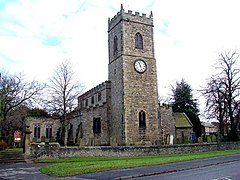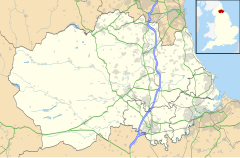world.wikisort.org - United_Kingdom
Lanchester is a village and civil parish in County Durham, England, 8 miles (13 km) west of Durham and 5 miles (8 km) from Consett. It had a population at the 2011 Census of 4,054.[1]
| Lanchester | |
|---|---|
 All Saints Church, Lanchester | |
 Lanchester Location within County Durham | |
| Population | 4,054 (2011) |
| OS grid reference | NZ165475 |
| Unitary authority |
|
| Ceremonial county |
|
| Region |
|
| Country | England |
| Sovereign state | United Kingdom |
| Post town | DURHAM |
| Postcode district | DH7 |
| Dialling code | 01207 |
| Police | Durham |
| Fire | County Durham and Darlington |
| Ambulance | North East |
| UK Parliament |
|
Although there was a small drift mine on the edge of the village which closed in the 1970s, Lanchester's economy was mainly based on agriculture. It is now a residential village in which a number of housing estates have been developed since the late 1960s.
History
The earliest occupation on the site is the Roman auxiliary fort located just southwest of Lanchester (grid reference NZ159469. Longovicium lay on the Roman road leading north from Eboracum (York), known as Dere Street. It is situated between the forts of Vindomora (Ebchester) and Vinovia (Binchester). The fort dates to AD 140,[2] covers almost 6 acres (2.4 ha),[2] and housed around 1,000-foot soldiers and cavalry. The fort foundations are well preserved, but there has only been minor excavation work carried out in 1937.
Stone from the fort was used in the construction of All Saints' Church, which has a Roman altar in its porch. It is one of many altars found in or near the fort, and was found in 1893.[3]
Andrew Breeze has argued that the Battle of Brunanburh took place at the Roman fort of Longovicium. He interprets Brunanburh as meaning 'stronghold of the River Browney.'[4]
Governance
An electoral ward in the same name exists. The population of this ward taken at the 2011 Census was 7,446.[5]
Education
The schools at Lanchester include St Bede's Catholic School and Sixth Form College. There are also two primary schools: Lanchester All Saints' RC Primary School and Lanchester Endowed Parochial (E.P) This latter has since moved about 50 yards (46 m) to new premises and the old school is now the village hall. The school has a nursery, an infants department and a juniors department.
Religious sites
All Saints Parish church
The main Parish church is now known as All Saints but was once called St. Mary the Virgin.[6] The original building dates from the mid 12th Century but was extended in 1284 by Antony Bek, the bishop of Durham. The tower dates from c.1430.[6] Features of interest include the Norman chancel arch, the monolithic columns of the nave (presumably from the Lanchester Roman station) and a Roman altar in the porch.[7]
College of Lanchester
The parish of Lanchester was originally very large, covering sixty-eight miles².[6] To profit from this Anthony Bek created a Deanery and College of Canons at the church in 1284 and extended it to accommodate the increased numbers of clergy.[6] The college consisted of a Dean and seven Prebendarys who each held a share in the church's revenues.[6] Bek created a set of statutes and ordinances for the College which were confirmed by Edward I in 1293.[8] The church supplemented its income by monopolising the sale of religious items such as holy water to the surrounding villages.[8]
By the 15th century, the college was falling out of use and the church fell into a poor state of repair with "gaping ruins" in the church, Deanery and the canons' houses.[6] By the time Henry VIII dissolved the monasteries the College and Deanery were abolished and the church returned to perpetual curacy.[6]
Other churches

The other churches within Lanchester are the All Saints' Catholic church and the Methodist Church which is centred in the heart of the village.
Notable residents
- Canon William Greenwell (1820–1918), inventor of the Greenwell's Glory fly-fishing fly.
- Dorothy (Dora) Greenwell (1821–82), poet, born at Greenwell Ford.
- Henry Nicholas Greenwell (1826–91), developer of Kona coffee[9]
- George Hedley (1882-1937), professional footballer, born in Lanchester
- Steven Sproat (born 1960), ukulele player
- Liam McGough, Big Brother contestant
References
- "Parish population 2011". Retrieved 2 July 2015.
- Graham, Frank (1979). Roman Durham. Newcastle upon Tyne: Frank Graham. p. 17. ISBN 0-85983-155-8.
- Roman Inscriptions of Britain – the Northern Borders (Lanchester) Archived 16 June 2010 at the Wayback Machine
- Breeze, Andrew (4 December 2014). "Brunanburh in 937: Bromborough or Lanchester?". Society of Antiquaries of London: Ordinary Meeting of Fellows. Retrieved 4 April 2015.
- Havery, Gavin (4 October 2013). "Lanchester – birthplace of a unified kingdom?". The Northern Echo. Archived from the original on 4 April 2015. Retrieved 4 April 2015.
- "Ward population 2011". Retrieved 13 July 2015.
- Gibby, Clifford (1965), Lanchester Parish Church, Gloucester: British Publishing Company
- Betjeman, John, ed. (1968) Collins Pocket Guide to English Parish Churches; the North. London: Collins; p. 131
- The History and Antiquities of the County Palatine of Durham, vol. II, London: Nichols and Son, 1820
- Sir Bernard Burke (1871). A genealogical and heraldic dictionary of the landed gentry of Great Britain & Ireland. Vol. 1 (5th ed.). Harrison. p. 543.
External links
- Lanchester All Saints Archaeological Assessment
- Lanchester All Saints Listed Buildings Entry
- Lanchester Parish Council
- Subterranea Britannica entry on Lanchester Station.
- Historic England Info on Roman Fort
- St. Bede's Catholic School and Sixth Form College
- Derwentside College Lanchester Centre
- Lanchester Bowling Club
- Lanchester Community Centre
Другой контент может иметь иную лицензию. Перед использованием материалов сайта WikiSort.org внимательно изучите правила лицензирования конкретных элементов наполнения сайта.
WikiSort.org - проект по пересортировке и дополнению контента Википедии